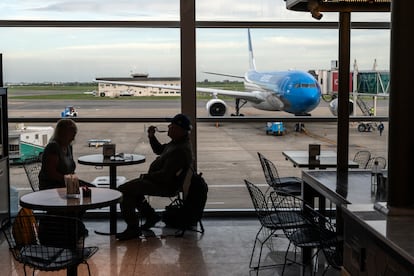The two faces of Milei’s Argentina: Trips abroad are increasing, but many can’t make ends meet
The economic recovery is concentrated in the wealthiest sectors of society, while the middle and lower classes are cutting back and suffering from rising unemployment

Tens of thousands of Boca Juniors and River Plate fans traveled to the United States this June to support their teams in the Club World Cup. Months earlier, during the southern hemisphere summer, Argentines filled the beaches of Brazil and the shopping malls of Chile. New car sales have soared 84% in the first months of 2025, and real estate sales by 66%. But the consumer boom reflected in these statistics masks growing inequality in Argentina under President Javier Milei. A privileged minority is reliving the travel and shopping boom of the 1990s thanks to a strong peso and a cheap dollar; the middle and lower classes of society, on the other hand, are increasingly cutting back on spending to make ends meet.
The main objective of Milei’s plan was and still is to control inflation. After his first year and a half in office, his results are his main strength. The price index fell from 12.8% monthly in November 2023, before Milei’s inauguration, to 1.5% last May. For much of 2024, the fiscal and monetary adjustment and economic deregulation generated a deep recession. But the scenario in 2025 is different. Official data indicate that the country’s gross domestic product (GDP) has seen three consecutive quarters of growth, albeit slowing: the quarter-on-quarter expansion rate was 3.9% in the third quarter of last year and 0.8% in the first quarter of 2025.
While the right-wing government celebrates the economic recovery and financial stabilization achieved after a new multi-billion-dollar bailout from the International Monetary Fund (IMF), analysts and leaders from various political, economic and social sectors warn of a worrying downside, where rising inequality, unemployment, and the external deficit, among other problems, converge.
“Today’s Argentina is a dual society with dual consumption,” explains the consultant Guillermo Oliveto. This specialist in social and consumer trends emphasizes that the flip side of the significant increase in sales of durable goods such as cars, homes and appliances is a year-over-year drop in purchases of beverages, food and medicines. The decline in supermarket consumption will exacerbate the slump the country experienced in 2024.
Oliveto, author of the book Middle Class: Myth, Reality, or Nostalgia, warns that the two ends of the social pyramid are increasingly distant. “What we’re seeing today is that around 30% of the population is taking advantage of the benefits of this economic model or has been able to accommodate itself to it. In the informal lower middle class and the non-poor lower class, those who don’t receive state benefits, you find a culture of ‘no’: no money, no top brands, no treats, no prizes, no outings. The month ends on the 20th.”
A report by the consulting firm Moiguer illustrates this divide. The document, titled “Pesified Argentina versus Dollarized Argentina,” notes that the strong economic recovery after months of recession “does not reach everyone and deepens current inequalities.” According to the report, 50% of people have incomes that are not enough to make ends meet, and 30% must postpone or cancel expenses to pay for services. At the same time, 23% are buying dollars — since the partial lifting of the so-called exchange rate restrictions in April — and 11% making purchases on foreign platforms. A clear example is spending on gasoline: demand for premium fuel has grown 18%, but demand for the cheapest fuel has decreased 1%.
Martín Eandi, director of research at the consulting firm Moiguer, emphasizes that Milei has implemented a model change that brings with it winners and losers. But even among the latter, who are struggling to meet daily expenses, expectations for future improvement are higher than in 2023, when inflation soared to over 200% annually. “The positive outlook went from 29-30% at the end of 2023 to 50%,” Eandi points out.
The social contrast is evident in other key economic data. The National Institute of Statistics and Census (INDEC) determined that unemployment in Argentina climbed to 7.9% in the first quarter of the year, its highest level since mid-2021, when it was still suffering the impact of the Covid pandemic. The unemployment rate rose 1.5 points compared to the previous quarter, while, at the same time, a marked process of job insecurity advanced: the number of formal (64% of salaried) and informal (36%) contracted workers fell, and self-employment grew.
The gap is also geographical and can be seen both between the country’s different provinces and within a single city: the north of Buenos Aires, the wealthiest area of the Argentine capital, is experiencing a construction boom fueled by the resurgence of mortgage loans and the opening of new businesses. In the poor neighborhoods of the south of the city, shutters are down and businesses are struggling to survive, especially small businesses that compete with imported goods. The unemployment rate in neighborhoods like Villa Soldati and Villa Lugano is more than double that of wealthy neighborhoods like Palermo.
In the same country facing job insecurity, 6.7 million Argentines traveled abroad for tourism in the first five months of this year, a record number for the last decade. Thanks to the appreciation of the peso — which many economists consider an unsustainable exchange rate lag — the number of tourists crossing borders increased by 66% compared to the same period in 2024. On the other hand, 20% fewer tourists visited Argentina, discouraged by the prices. Eating out in this South American country is as expensive as, or more expensive than, many European countries.
The loss of foreign currency from tourism, along with debt interest payments and other expenditures, resulted in an external deficit of $5.2 billion in the balance of payments for the first quarter of the year. The imbalance is almost double the amount expected by the IMF.
The combination of a cheap dollar and the dismantling of the state, along with rising debt, unemployment, and inequality, is fueling the fears of those who remember the neoliberal policies of the 1990s under the presidency of Carlos Menem. Milei’s government insists that this time, it will be different.
Sign up for our weekly newsletter to get more English-language news coverage from EL PAÍS USA Edition
Tu suscripción se está usando en otro dispositivo
¿Quieres añadir otro usuario a tu suscripción?
Si continúas leyendo en este dispositivo, no se podrá leer en el otro.
FlechaTu suscripción se está usando en otro dispositivo y solo puedes acceder a EL PAÍS desde un dispositivo a la vez.
Si quieres compartir tu cuenta, cambia tu suscripción a la modalidad Premium, así podrás añadir otro usuario. Cada uno accederá con su propia cuenta de email, lo que os permitirá personalizar vuestra experiencia en EL PAÍS.
¿Tienes una suscripción de empresa? Accede aquí para contratar más cuentas.
En el caso de no saber quién está usando tu cuenta, te recomendamos cambiar tu contraseña aquí.
Si decides continuar compartiendo tu cuenta, este mensaje se mostrará en tu dispositivo y en el de la otra persona que está usando tu cuenta de forma indefinida, afectando a tu experiencia de lectura. Puedes consultar aquí los términos y condiciones de la suscripción digital.
More information
Archived In
Últimas noticias
Maduro to be tried in the US for narcoterrorism and corruption
Maps of the US attack on Venezuela: Targets, airspace and deployed fleet
Venezuelans in exile: ‘This could be the end of a very dark chapter for Venezuela, but also the beginning of a time of uncertainty’
Key points of the military attack on Venezuela: Early morning bombings and a ‘captured’ president
Most viewed
- Alain Aspect, Nobel laureate in physics: ‘Einstein was so smart that he would have had to recognize quantum entanglement’
- David King, chemist: ‘There are scientists studying how to cool the planet; nobody should stop these experiments from happening’
- Mexico completes its trade shift with the entry into force of tariffs on China and countries without trade agreements
- Reinhard Genzel, Nobel laureate in physics: ‘One-minute videos will never give you the truth’
- Oona Chaplin: ‘I told James Cameron that I was living in a treehouse and starting a permaculture project with a friend’










































